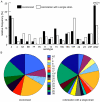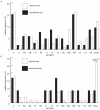Multiple colonization with S. pneumoniae before and after introduction of the seven-valent conjugated pneumococcal polysaccharide vaccine
- PMID: 20661289
- PMCID: PMC2905437
- DOI: 10.1371/journal.pone.0011638
Multiple colonization with S. pneumoniae before and after introduction of the seven-valent conjugated pneumococcal polysaccharide vaccine
Abstract
Background: Simultaneous carriage of more than one strain of Streptococcus pneumoniae promotes horizontal gene transfer events and may lead to capsule switch and acquisition of antibiotic resistance. We studied the epidemiology of cocolonization with S. pneumoniae before and after introduction of the seven-valent conjugated pneumococcal vaccine (PCV7).
Methodology: Nasopharyngeal swabs (n 1120) were collected from outpatients between 2004 and 2009 within an ongoing nationwide surveillance program. Cocolonization was detected directly from swabs by restriction fragment length polymorphism (RFLP) analysis. Serotypes were identified by agglutination, multiplex PCR and microarray.
Principal findings: Rate of multiple colonization remained stable up to three years after PCV7 introduction. Cocolonization was associated with serotypes of low carriage prevalence in the prevaccine era. Pneumococcal colonization density was higher in cocolonized samples and cocolonizing strains were present in a balanced ratio (median 1.38). Other characteristics of cocolonization were a higher frequency at young age, but no association with recurrent acute otitis media, recent antibiotic exposure, day care usage and PCV7 vaccination status.
Conclusions: Pneumococcal cocolonization is dominated by serotypes of low carriage prevalence in the prevaccine era, which coexist in the nasopharynx. Emergence of such previously rare serotypes under vaccine selection pressure may promote cocolonization in the future.
Conflict of interest statement
Figures



References
-
- Poehling KA, Talbot TR, Griffin MR, Craig AS, Whitney CG, et al. Invasive pneumococcal disease among infants before and after introduction of pneumococcal conjugate vaccine. JAMA. 2006;295:1668–1674. - PubMed
-
- Kyaw MH, Lynfield R, Schaffner W, Craig AS, Hadler J, et al. Effect of introduction of the pneumococcal conjugate vaccine on drug-resistant Streptococcus pneumoniae. N Engl J Med. 2006;354:1455–1463. - PubMed
-
- Whitney CG, Farley MM, Hadler J, Harrison LH, Bennett NM, et al. Decline in invasive pneumococcal disease after the introduction of protein-polysaccharide conjugate vaccine. N Engl J Med. 2003;348:1737–1746. - PubMed
-
- Singleton RJ, Hennessy TW, Bulkow LR, Hammitt LL, Zulz T, et al. Invasive pneumococcal disease caused by nonvaccine serotypes among alaska native children with high levels of 7-valent pneumococcal conjugate vaccine coverage. JAMA. 2007;297:1784–1792. - PubMed

